玄奘と二大訳聖の足跡!四大訳経家が遺した『大唐西域記』の軌跡と影響

The Footprints of Xuanzang and the Two Great Translators: Tracing the Path and Impact of the “Great Tang Records on the Western Regions” Left by the Four Great Translators
イントロダクション
玄奘三蔵法師の伝説的な旅は、彼と他の三人の訳経家たちによって編纂された『大唐西域記』に色濃く反映されています。
この古典は、彼らが経験した文化的、宗教的交流の多様性と、その時代の仏教思想への深い洞察を提供しています。
本記事では、玄奘の壮大な足跡と、後の世に与えた影響を探ります。
彼らの旅と翻訳作業が、どのようにして東アジアの仏教発展に寄与したのかを明らかにし、その遺産の重要性を解き明かしていきます。
Introduction
The legendary journey of Xuanzang, the Tripitaka Master, is vividly captured in the “Great Tang Records on the Western Regions,” compiled by him and three other translators. This classical work offers profound insights into the cultural and religious exchanges they encountered, as well as deep reflections on Buddhist thought of their era.
This article explores the grand footsteps of Xuanzang and the impact he left on future generations. It delves into how their journeys and translation efforts contributed to the development of Buddhism in East Asia, unraveling the significance of their legacy.
玄奘とは?―伝説の旅と二大訳聖までの道のり
玄奘は、唐代の高僧であり、伝説的な旅を経て仏教経典の翻訳に尽力した人物です。
彼の生涯は、仏教への深い帰依から始まりました。
その献身は、中国仏教における経典翻訳の歴史において重要な役割を果たしました。
彼が若い頃から示した仏教への関心は、やがて西域への壮大な冒険へと彼を導きました。
玄奘の旅路は、当時の政治的な制約を超えて、真理を求める彼の意志の表れでした。
この旅は、後に『大唐西域記』として知られる貴重な記録を残すこととなります。
帰国後、玄奘は訳経の功績で知られるようになりました。
彼は四大訳経家の一人として、サンスクリット語から中国語への翻訳において、その精確さと文学的な美しさで高い評価を受けました。
また、二大訳聖の一人として、彼の訳経作業は中国仏教の発展に多大な影響を及ぼしたのです。
玄奘の功績は、単に経典の翻訳に留まらず、彼の旅とその後の活動は、中国だけでなく、アジア全域の仏教文化においても、深い足跡を残しました。
彼の物語は、今日でも多くの人々に知られ、尊敬されています。
玄奘の生涯と仏教への帰依
玄奘は、唐時代の高僧であり、彼の仏教に対する深い帰依心は、中国仏教史において重要な役割を果たしました。
彼の名は、インドへの長い旅と、帰国後に行われた経典の翻訳作業によって、特に知られています。
『大唐西域記』の著者としても知られる玄奘は、その精密な記述で、中国だけでなく世界中の仏教研究に貢献しています。
玄奘の旅は、彼が仏教の真髄を求めて、当時の国境を越えて西域へと旅立ったことに始まります。
この危険を顧みずに行われた旅路は、彼が経験した数多くの試練と、仏教への深い帰依心を象徴しています。
玄奘は、その旅を通じて、仏教の教えを深く理解し、さらにはその普及に尽力しました。
帰国後、玄奘は「二大訳聖」の一人として、その名を歴史に刻みました。
彼は、インドから持ち帰った仏教経典の翻訳において、その卓越した学識を発揮しました。
彼の翻訳作業は、後に「四大訳経家」に数えられるほどの影響を及ぼし、中国仏教の発展に不可欠な貢献をしました。
玄奘の生涯は、仏教への帰依だけでなく、学問への情熱と、翻訳における厳密さによっても特徴づけられます。
その結果、彼は多くの仏教徒にとって尊敬される存在となり、彼の教えや翻訳は今日に至るまで多くの人々に影響を与え続けています。
玄奘の精神は、仏教の歴史を語る上で欠かせない要素であり、彼の功績は時を超えて讃えられるに値します。
西域への冒険:玄奘の旅路とその意義
玄奘は、唐の時代に中国からインドへと壮大な旅をした仏教僧であり、彼の旅は後に「西域への冒険」と称されるようになりました。
彼の生涯は、仏教教義の深い理解とその普及に捧げられました。
彼が西域、すなわち中央アジアからインドへと足を踏み入れた理由は、純粋で正確な仏教の教えを学び、それを中国に持ち帰ることにありました。
玄奘の旅路は、彼が直面した困難と危険に満ちていましたが、その旅は中国における仏教の発展にとって非常に重要でした。
彼は、当時の中国で知られていた仏教経典の多くに誤訳や誤解があることを発見し、これを正すためにインドへと向かったのです。
その過程で、彼は多くの国々を訪れ、様々な文化や仏教の実践を目の当たりにしました。
玄奘が帰国した後、彼は二大訳聖の一人として称えられ、多くの仏教経典を中国語に翻訳しました。
これらの翻訳作業は、彼を四大訳経家の一人に数えるほどの影響力を持ち、後の世に大きな遺産を残すこととなりました。
特に『大唐西域記』は、彼の旅行記としてだけでなく、当時の地理や文化に関する貴重な情報源としても価値があります。
玄奘の功績は、単に文献の翻訳に留まらず、彼の旅が示した冒険と探求の精神は、後世の人々にとっても大きなインスピレーションとなっています。
彼の旅路は、知識を求める旅であり、その過程で得られた教えは、今日でも多くの人々にとって重要な意味を持っています。
玄奘は、仏教の教えを正しく伝え、広めることに人生を捧げたことで、永遠に記憶される人物となりました。
帰国後の活躍と訳経の功績
玄奘は、唐の時代に中国からインドまでの長い旅を経て、多くの仏典を持ち帰り、その翻訳に尽力した高僧です。
彼の生涯は、仏教の教えに深く帰依し、真理を求める姿勢が色濃く反映されています。
玄奘の西域への旅は、単なる冒険にとどまらず、仏教文化の交流と発展に大きな影響を与えました。
彼が持ち帰った経典の翻訳作業は、中国仏教史上、画期的な出来事であり、二大訳聖の一人と称されるほどの業績を残しました。
四大訳経家に数えられる玄奘の翻訳は、その精確さと文学的な美しさで知られ、後世に多大な影響を与えました。
また、彼が記した『大唐西域記』は、当時のインドや中央アジアの地理、文化、宗教に関する貴重な情報源として、今日でも研究者たちによって重宝されています。
帰国後、玄奘は翻訳において厳密な方法論を採用し、テキストの意味を正確に伝えることに努めました。
彼の翻訳した経典は、中国仏教の教義を形作る上で不可欠なものとなり、彼自身も高い評価を受けています。
玄奘の功績は、単に経典の翻訳に留まらず、中国仏教の発展という大きな流れの中で、その真摯な探求心と献身的な努力によって形作られたものです。
Xuanzang: The Journey of Legend and the Path to Becoming a Great Translator
Xuanzang was a renowned monk of the Tang Dynasty, who devoted himself to translating Buddhist scriptures after embarking on a legendary journey.
His life began with a deep devotion to Buddhism.
His dedication played a crucial role in the history of translating scriptures in Chinese Buddhism.
From a young age, his interest in Buddhism eventually led him to a grand adventure into the Western Regions.
Xuanzang’s journey was a testament to his determination to seek truth beyond the political constraints of his time.
This journey later resulted in the invaluable record known as the “Great Tang Records on the Western Regions.”
Upon his return, Xuanzang became renowned for his translation achievements.
As one of the Four Great Translators, his translations from Sanskrit into Chinese were highly praised for their accuracy and literary beauty.
Additionally, as one of the Two Great Masters of Translation, his work significantly influenced the development of Chinese Buddhism.
Xuanzang’s contributions extend beyond mere translation of scriptures; his journey and subsequent activities left a profound mark not only on China but also on Buddhist cultures across Asia.
His story continues to be widely known and respected today.
Xuanzang and His Devotion to Buddhism
Xuanzang, a monk of the Tang Dynasty, played a significant role in Chinese Buddhist history due to his deep devotion to Buddhism.
His name became particularly well-known for his extensive journey to India and subsequent translation work of Buddhist scriptures upon his return.
Known also as the author of the “Great Tang Records on the Western Regions,” Xuanzang contributed extensively to global Buddhist studies with his meticulous accounts.
Xuanzang’s journey began with his quest for the essence of Buddhism, prompting him to venture to the Western Regions beyond the borders of his time.
This perilous journey, undertaken without hesitation, symbolized both his numerous trials and his profound devotion to Buddhism.
Through his journey, Xuanzang gained a deep understanding of Buddhist teachings and further dedicated himself to their propagation.
Upon returning home, Xuanzang was revered as one of the “Two Great Masters of Translation,” etching his name into history.
His exceptional scholarship in translating Buddhist scriptures from India earned him high acclaim.
His translations, later counted among the “Four Great Translators,” made indispensable contributions to the development of Chinese Buddhism.
Xuanzang’s life was characterized not only by his devotion to Buddhism but also by his passion for scholarship and the rigorous precision of his translations.
As a result, he became a respected figure among Buddhists, and his teachings and translations continue to influence many people to this day.
The Adventure to the Western Regions: Xuanzang’s Journey and Its Significance
Xuanzang, a Buddhist monk of the Tang Dynasty, embarked on a grand journey from China to India, later dubbed the “Adventure to the Western Regions.”
His life was dedicated to a deep understanding of Buddhist doctrine and its propagation.
His footsteps into the Western Regions—Central Asia to India—were driven by a pure desire to learn accurate Buddhist teachings and bring them back to China.
Xuanzang’s journey was fraught with challenges and dangers, yet it was crucial for the development of Buddhism in China.
He discovered many mistranslations and misunderstandings in the Buddhist scriptures known in China at that time, prompting his journey to India to correct them.
During this process, he visited many countries and witnessed various cultures and Buddhist practices firsthand.
Upon returning home, Xuanzang was celebrated as one of the “Two Great Masters of Translation” for his efforts.
He translated many Buddhist scriptures from India into Chinese with exceptional scholarly rigor.
His translations, which later earned him recognition as one of the “Four Great Translators,” had a profound impact and left a significant legacy for future generations.
In particular, the “Great Tang Records on the Western Regions” serves not only as his travelogue but also as a valuable source of information on the geography, culture, and religions of India and Central Asia at that time.
Xuanzang’s achievements extend beyond mere translation; his adventurous spirit and quest for knowledge continue to inspire many people today.
His journey was a quest for knowledge, and the teachings he acquired along the way hold significant meaning for many people even now.
Xuanzang is remembered as a figure who dedicated his life to accurately conveying and spreading Buddhist teachings, leaving an enduring legacy in the history of Buddhism.
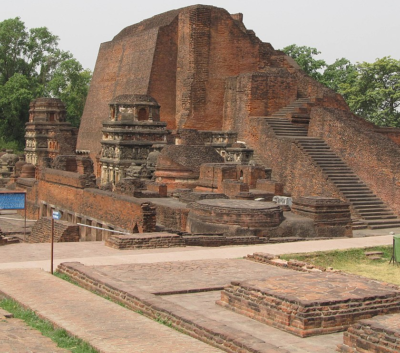
Nalanda Monastery
四大訳経家とその遺した宝―『大唐西域記』を中心に
四大訳経家は、中国仏教史において経典の翻訳に大きな役割を果たした僧侶たちを指します。
中でも玄奘は、その卓越した翻訳技術と『大唐西域記』によって特に知られています。
『大唐西域記』は、玄奘がインドへの旅から持ち帰った仏教経典の知識とともに、彼が見聞きした様々な国々の風土や文化を記録した貴重な文献です。
この作品は、後世の仏教研究だけでなく、歴史や地理の研究にも欠かせないものとなっています。
玄奘自身は、その生涯で数多くの仏教経典を翻訳し、中国仏教の発展に大きく貢献しました。
彼は二大訳聖の一人としても讃えられ、その翻訳作業は非常に精密かつ緻密であったとされています。
玄奘が翻訳した経典は、彼の厳格な校正と解釈を経て、より正確な仏教教義の伝達を可能にしました。
『大唐西域記』は、玄奘の著作の中でも特に重要な位置を占めています。
この記録は、彼が経験した苦難の旅を通じて得た貴重な知見を含んでおり、当時の西域の宗教、政治、経済、文化の状況を詳細に伝えています。
そのため、この文献は単なる旅行記にとどまらず、当時のアジアの諸国間の交流を理解する上での重要な資料となっています。
四大訳経家の功績は、彼らが残した経典や記録を通じて、現代にもその影響を与え続けています。
玄奘の『大唐西域記』をはじめとするこれらの文献は、仏教学のみならず、歴史や文化研究の分野での宝として、今も高く評価されています。
四大訳経家とは―玄奘を含む影響力ある僧侶たち
四大訳経家とは、 110部143巻もの経典を漢訳し、不空金剛・ 鳩摩羅什 ・ 真諦 とともに、四大訳経家と呼ばれる。
四大訳経家は、中国の仏教史において、経典翻訳において顕著な業績を残した四人の僧侶を指します。
これらの僧侶たちは、仏教経典の翻訳と解釈において、それぞれ特異な才能を発揮し、後世に大きな影響を与えたことで知られています。
玄奘は、このグループの中でも特に著名な存在で、彼の翻訳作業は、仏教の教義がより広範な地域で理解されるための基盤を築きました。
『大唐西域記』は、玄奘がインドへの旅から帰還した後に記したもので、彼が見聞きした仏教の聖地や風習、さらには当時の社会や文化に関する貴重な記録を含んでいます。
この文献は、当時のアジアの地理や宗教に関する知識を大きく広げるものであり、仏教研究だけでなく、歴史や文化研究においても重要な資料とされています。
玄奘の著作としての『大唐西域記』は、その詳細な記述と精密な観察により特筆されます。
彼は、経典の内容をただ翻訳するだけでなく、その背景にある哲学や教えを深く掘り下げ、中国における仏教の理解を一層深めることに貢献しました。
玄奘の翻訳作業は、後の訳経家たちにとっても模範となり、彼らの翻訳技術や解釈の方法論に大きな影響を与えたとされています。
このように、四大訳経家というのは、仏教経典の翻訳における革新的な働きをした僧侶たちの集まりであり、玄奘をはじめとするこれらの僧侶は、仏教の普及と発展に不可欠な役割を果たしました。
彼らの遺した著作や訳経は、今日でも多くの研究者や実践者によって読まれ、仏教の教えを世界に広めるための基盤となっています。
The Four Great Translators and Their Legacy: Focusing on the “Great Tang Records on the Western Regions”
The Four Great Translators were monks who played a pivotal role in translating Buddhist scriptures in Chinese Buddhist history. Among them, Xuanzang stands out for his exceptional translation skills and his work, the “Great Tang Records on the Western Regions.”
This valuable document not only includes the Buddhist knowledge Xuanzang brought back from his journey to India but also records the diverse cultures and climates of various countries he encountered. This work remains indispensable for both Buddhist studies and historical and geographical research.
Throughout his life, Xuanzang translated numerous Buddhist scriptures, significantly contributing to the development of Chinese Buddhism. He is also celebrated as one of the Two Great Masters of Translation, known for the precision and meticulousness of his translation efforts.
The scriptures translated by Xuanzang, refined through his strict editing and interpretation, facilitated the accurate transmission of Buddhist teachings. Among his works, the “Great Tang Records on the Western Regions” holds a particularly prominent position. This record contains invaluable insights obtained through his arduous journey, detailing the religious, political, economic, and cultural conditions of the Western Regions during that time.
As a result, this document is not merely a travelogue but a crucial resource for understanding the interactions among Asian countries during that era. The achievements of the Four Great Translators continue to influence modern times through the scriptures and records they left behind. Works such as Xuanzang’s “Great Tang Records on the Western Regions” are highly regarded not only in Buddhist studies but also in the fields of history and cultural research.
The Four Great Translators: Xuanzang and Other Influential Monks
The Four Great Translators are renowned for translating 110 scriptures into 143 volumes of Chinese Buddhist texts. They include eminent figures such as Amoghavajra, Kumarajiva, Paramartha, and Xuanzang.
These monks made significant contributions to the translation and interpretation of Buddhist scriptures, each showcasing unique talents and leaving a lasting impact on subsequent generations. Xuanzang stands out in this group for his foundational work in making Buddhist teachings comprehensible to a broader audience.
Xuanzang’s “Great Tang Records on the Western Regions,” written after his return from India, provides a detailed account of Buddhist holy sites, customs, and the societal and cultural contexts of the time. This text greatly expanded contemporary knowledge of Asian geography and religions, making it invaluable not only to Buddhist studies but also to historical and cultural research.
Xuanzang’s writings, particularly the “Great Tang Records on the Western Regions,” are noted for their detailed descriptions and precise observations. His translations went beyond mere textual conversion; he delved deeply into the philosophy and teachings behind the scriptures, enhancing the understanding of Buddhism in China.
His meticulous translation work set a high standard for future translators and significantly influenced their methodologies and interpretive approaches. The Four Great Translators collectively represented a pioneering force in Buddhist scripture translation, with monks like Xuanzang playing an indispensable role in the spread and development of Buddhism.
The works and translations left by these monks are still read by many researchers and practitioners today, serving as a foundation for spreading Buddhist teachings worldwide.
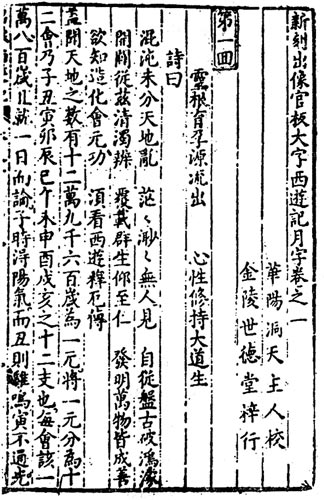
The Jinling Edition of “Journey to the West” by Shidetang
『大唐西域記』の内容とその価値
『大唐西域記』は、唐の時代に玄奘が著した旅行記であり、彼がインドへの長い旅を通じて仏教経典を学び、後に中国に持ち帰った歴史的文献です。
この書は、彼の詳細な旅行の記録、仏教聖地の描写、さらには当時の社会、文化、政治に関する貴重な情報を提供しています。
玄奘は、二大訳聖の一人として、また四大訳経家の一員として、中国仏教史上非常に重要な位置を占めています。
彼の『大唐西域記』は、その正確な記述と豊かな内容により、宗教的な価値だけでなく、歴史的、地理的な価値も高いと評価されています。
玄奘の著作としての『大唐西域記』は、その文体と構成においても特徴的です。
彼は経典の翻訳者でありながら、旅行記という形式を通じて、仏教哲学や経典の解釈を広めることに成功しました。
この文献は、宗教的な教義を超えて、多くの学者や歴史家にとっても研究の対象となっています。
『大唐西域記』は、玄奘が見聞きしたことを詳細に記録した作品であり、彼の厳密な観察力と分析力が反映されています。
彼の旅は、中国とインド間の文化交流を促進し、後世に多大な影響を及ぼしたことは疑いありません。
この記録は、現代においても仏教研究のみならず、アジアの歴史や文化を理解する上で欠かせない資料となっています。
The Content and Value of “The Great Tang Records on the Western Regions”
“The Great Tang Records on the Western Regions” is a travelogue written by Xuanzang during the Tang Dynasty, documenting his long journey to India where he studied Buddhist scriptures and later brought them back to China.
This work provides a detailed account of his travels, descriptions of Buddhist holy sites, and valuable information on the society, culture, and politics of the time.
Xuanzang holds a highly significant position in Chinese Buddhist history as one of the Two Great Masters of Translation and a member of the Four Great Translators.
His “Great Tang Records on the Western Regions” is esteemed not only for its religious value but also for its historical and geographical insights due to its precise descriptions and rich content.
Xuanzang’s travelogue is notable for its distinctive style and structure. Although primarily a translator of scriptures, he successfully used the format of a travel diary to disseminate Buddhist philosophy and interpretations of scriptures.
This document extends beyond religious doctrine, serving as a subject of study for many scholars and historians.
“The Great Tang Records on the Western Regions” is a meticulously detailed record of Xuanzang’s observations, showcasing his keen eye for detail and analytical skills.
His journey undoubtedly facilitated cultural exchange between China and India, leaving a profound impact on subsequent generations. Even today, this record is an indispensable resource for understanding not only Buddhist studies but also the broader history and culture of Asia.
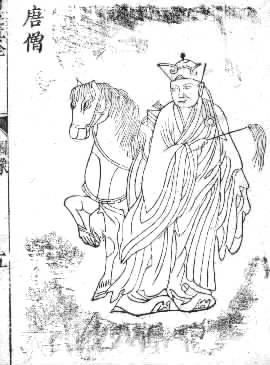
Journey to the West: True Interpretation – Image 5: Tang Monk (Tripitaka)
玄奘の著作としての『大唐西域記』の特徴
玄奘は、中国仏教史において重要な位置を占める僧侶であり、彼の旅行記「大唐西域記」は、彼が行った長い旅の記録です。
四大訳経家の一人として、玄奘はその深い仏教知識と翻訳における卓越した技術で知られています。
彼は二大訳聖の一角を成すほどの影響力を持ち、その著作は後世に多大な影響を与えました。
「大唐西域記」の内容は、玄奘がインドを始めとする西域諸国を巡礼し、仏教の聖地を訪れた記録を詳細に描写しています。
この文献は、地理学的な記述だけでなく、当時の社会、経済、文化、宗教に関する貴重な情報を提供しており、研究者にとっては無くてはならない資料となっています。
玄奘の「大唐西域記」は、彼の観察力の鋭さと、記録に対する厳密な姿勢が特徴です。
彼はただの旅行記を超えて、訪れた土地の風俗や習慣、言語についても詳細に記述し、それらを通じて仏教の教えを広めようとしたのです。
また、玄奘の著作は、彼が直面した困難や試練を克服しながら得た、貴重な仏教経典の翻訳と解釈に対しても、大きな尊敬を集めています。
彼の翻訳作業は、中国仏教の発展において欠かせないものであり、その影響は今日に至るまで続いています。
総じて、「大唐西域記」は玄奘の著作としてその学問的な深さと、彼の旅が持つ歴史的重要性を示しています。
この記録は、当時のアジアの宗教的および文化的な様相を理解する上で、貴重な一次資料となっているのです。
The Distinctive Features of Xuanzang’s “Great Tang Records on the Western Regions”
Xuanzang holds a significant place in the history of Chinese Buddhism, and his travelogue, “Great Tang Records on the Western Regions,” documents his extensive journeys.
As one of the Four Great Translators, Xuanzang is renowned for his profound Buddhist knowledge and exceptional translation skills.
He is also recognized as one of the Two Great Masters of Translation, and his works have had a lasting impact.
The “Great Tang Records on the Western Regions” detail Xuanzang’s pilgrimage through India and other Western regions, including visits to key Buddhist sites.
This document provides not only geographical descriptions but also invaluable information on the social, economic, cultural, and religious aspects of the regions during his time, making it indispensable for researchers.
Xuanzang’s “Great Tang Records on the Western Regions” are characterized by his keen observation and meticulous recording.
Beyond being a mere travelogue, it offers detailed descriptions of the customs, languages, and traditions of the lands he visited, aiming to spread Buddhist teachings through these insights.
Xuanzang’s work is highly respected for the valuable Buddhist scriptures he translated and interpreted, which he acquired despite numerous challenges and hardships.
His translations were crucial for the development of Chinese Buddhism, and their influence endures to this day.
Overall, “Great Tang Records on the Western Regions” exemplifies Xuanzang’s scholarly depth and the historical significance of his travels.
This record remains a vital primary source for understanding the religious and cultural landscape of Asia during his era.
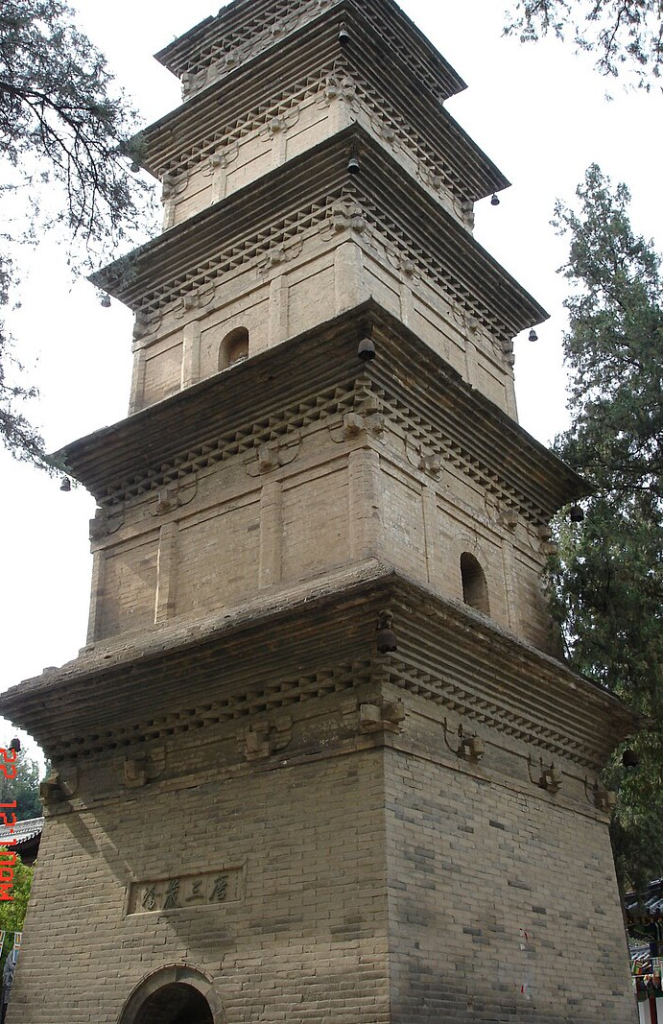
World Cultural Heritage: Hokyo-ji Temple Sharito Pagoda
玄奘の遺したもの―墓所、遺骨、そして法相宗
玄奘は、唐代の高僧であり、彼の生涯と業績は後世に大きな影響を与え続けています。
彼は「二大訳聖」として知られ、仏教経典の中国語への翻訳において重要な役割を果たしました。
また、「四大訳経家」の一人としても名を馳せ、その翻訳作業は法相宗の教義を形作る基盤となりました。
玄奘の墓所は、今も中国に残り、多くの人々が彼を偲んで訪れます。
彼の遺骨は、仏教遺物として崇敬され、その存在は仏教徒にとって重要な意味を持っています。
玄奘の冒険と学問の旅は『大唐西域記』に記されており、この著作は後世の旅行者や研究者にとって貴重な情報源となっています。
法相宗は、玄奘の教えに大きく影響を受けた仏教の宗派です。
彼が伝えた経典や哲学は、日本を含む東アジアの仏教文化において重要な位置を占めています。
玄奘の教えは、日本の仏教宗派にも影響を与え、彼の翻訳した経典は今日でも研究され、実践されています。
玄奘の遺したものは、墓所や遺骨だけにとどまらず、彼が伝えた仏教の教義や思想、そして『大唐西域記』による歴史的記録にまで及んでいます。
彼の遺産は、現代においても多くの人々に尊敬され、学ばれ続けているのです。
玄奘の墓所と遺骨の現在
玄奘は中国唐代の僧であり、『大唐西域記』を著したことで知られています。
彼は「二大訳聖」の一人として尊敬され、「四大訳経家」の中でも特に重要な位置を占めています。
玄奘の墓所は現在、中国の陝西省長安区にあり、彼の遺骨はそこに安置されているとされています。
墓所は多くの仏教徒にとって重要な巡礼地の一つとなっており、玄奘の教えを今に伝える場所としても知られています。
また、玄奘は法相宗の祖としても尊崇されており、彼の訳経と教えは日本を含む東アジアの仏教文化に大きな影響を与えました。
法相宗は玄奘の教えを基に発展した学派であり、特に唯識学を重視しています。
日本では、玄奘の教えが空海や最澄といった僧侶を通じて伝わり、日本の仏教思想の形成に寄与しました。
玄奘の墓所と遺骨、そして法相宗に関する知識は、仏教研究だけでなく、文化史や宗教学の分野でも深い洞察を与えています。
彼の遺した『大唐西域記』は、当時の西域の地理、文化、宗教に関する貴重な情報源であり、今日でも多くの研究者によって引用されています。
玄奘の生涯と業績は、彼が遺した膨大な訳経とともに、仏教史における不朽の財産として尊ばれています。
法相宗と玄奘―その教えと日本における影響
玄奘は、中国唐代の高僧であり、『大唐西域記』の著者としても知られています。
彼は、インドへの長い旅を経て、仏教経典の精密な翻訳を行い、その功績から「二大訳聖」の一人と称えられています。
また、「四大訳経家」の一員として、中国仏教史において重要な位置を占めています。
玄奘の墓所は、今日でも中国において尊重され、多くの人々が彼の遺骨を拝むために訪れています。
これらの遺物は、彼の教えとともに、法相宗の伝播に大きな影響を与えました。
日本においては、法相宗は奈良時代に伝わり、玄奘の教えが広く受け入れられました。
彼の翻訳した経典は、日本の仏教哲学や宗教行事に深い影響を与え、今日に至るまでその価値が認められています。
玄奘の精神は、日本の寺院や学問の場で受け継がれ、彼の智慧と献身が教育や宗教的実践において重んじられています。
玄奘の旅と翻訳作業は、アジアの仏教文化における知識と教義の流通に対して、計り知れない貢献をしました。
その影響は、中国だけでなく、日本を含む多くの国々において、今なお色濃く残っています。
Xuanzang’s Legacy: His Tomb, Relics, and the Hosso Sect
Xuanzang, a prominent monk from the Tang Dynasty, left a lasting impact through his life and works.
He is revered as one of the “Two Great Translators,” playing a crucial role in translating Buddhist scriptures into Chinese.
As one of the “Four Great Translators,” his efforts laid the foundation for the teachings of the Hosso Sect.
Xuanzang’s tomb remains in China and continues to attract many who wish to pay their respects.
His relics are venerated as significant Buddhist artifacts, holding deep meaning for believers.
Xuanzang’s epic journey and scholarly pursuits are chronicled in the “Great Tang Records on the Western Regions,” a vital source for travelers and researchers alike.
The Hosso Sect, deeply influenced by Xuanzang’s teachings, holds an important place in East Asian Buddhism, including Japan.
His translations and philosophies continue to be studied and practiced, underscoring his enduring legacy.
Xuanzang’s contributions extend beyond his tomb and relics, encompassing his profound teachings and historical accounts in the “Great Tang Records on the Western Regions.”
Even today, his legacy inspires respect and scholarship across the globe.
The Current Status of Xuanzang’s Tomb and Relics
Xuanzang, a monk from the Tang Dynasty, is renowned for his work “Great Tang Records on the Western Regions.”
He is highly respected as one of the “Two Great Translators” and holds a key place among the “Four Great Translators.”
His tomb is located in Chang’an District, Shaanxi Province, China, where his relics are enshrined.
This site is a significant pilgrimage destination, preserving his teachings.
Xuanzang is also honored as the founder of the Hosso Sect, which has profoundly influenced East Asian Buddhist culture, including Japan.
The Hosso Sect, rooted in Xuanzang’s teachings, emphasizes Yogacara philosophy.
In Japan, his teachings were transmitted through monks like Kukai and Saicho, shaping Japanese Buddhist thought.
Knowledge about Xuanzang’s tomb, relics, and the Hosso Sect offers insights into Buddhist studies and cultural history.
His “Great Tang Records on the Western Regions” provides invaluable information on the geography, culture, and religion of the Western Regions, cited by many researchers today.
Xuanzang’s life and achievements, along with his extensive translations, remain an enduring treasure in Buddhist history.
Xuanzang and the Hosso Sect: His Teachings and Influence in Japan
Xuanzang, a distinguished monk from the Tang Dynasty, is also known for his authorship of the “Great Tang Records on the Western Regions.”
After a long journey to India, he meticulously translated Buddhist scriptures, earning him the title of one of the “Two Great Translators.”
He holds a significant position among the “Four Great Translators” in Chinese Buddhist history.
Xuanzang’s tomb continues to be a respected site in China, with many visiting to honor his relics.
These relics, along with his teachings, played a crucial role in spreading the Hosso Sect.
In Japan, the Hosso Sect was introduced during the Nara period, with Xuanzang’s teachings widely embraced.
His translated scriptures deeply influenced Japanese Buddhist philosophy and religious practices, their value recognized to this day.
Xuanzang’s spirit is preserved in Japanese temples and academic settings, where his wisdom and dedication are highly regarded.
His travels and translation efforts significantly contributed to the dissemination of Buddhist knowledge and doctrines across Asia.
The impact of Xuanzang’s work remains strong in many countries, including Japan, illustrating his profound and lasting influence.
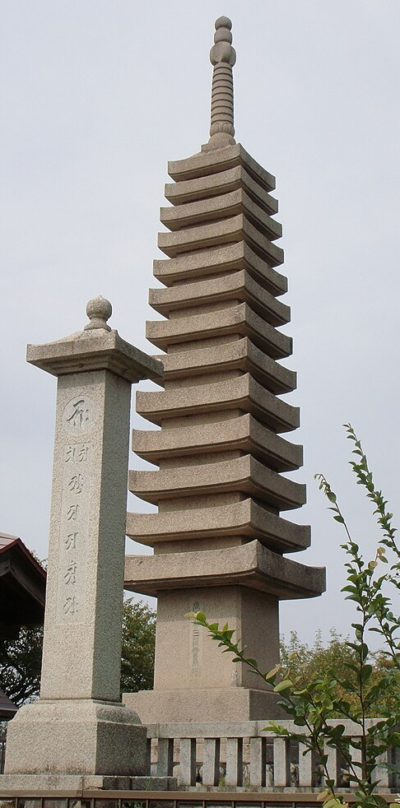
Cien Temple’s Xuanzang Pagoda (Iwatsuki Ward, Saitama City)
玄奘を題材にした作品―『西遊記』から現代への影響
玄奘三蔵法師は、中国の仏教史において重要な人物であり、その生涯と旅は後の世に多くの創作物へと影響を与えました。
最も有名な作品は、疑い無く『西遊記』です。
この物語は、彼が取経の旅に出ることを決意し、仏教経典を求めて西域へと向かった実際の出来事を基にしています。
しかし、この叙事詩では、玄奘は三蔵法師として描かれ、神話的な要素が豊富に盛り込まれています。
『西遊記』において玄奘は、孫悟空、猪八戒、沙悟浄といった弟子たちと共に数々の試練を乗り越えながら、経典を取得するための旅を続けます。
この物語は、玄奘の実際の経典翻訳作業とは異なる、冒険と奇想天外な出来事に満ちたものとなっていますが、その背後には、彼の精神的な探求と仏教の普及への貢献が反映されていると言えるでしょう。
また、玄奘の仏教に対する深い洞察と経典への貢献は、彼を「二大訳聖」として位置づける要因となりました。
彼は、仏教徒にとって尊敬すべき「四大訳経家」の一人としても認知されています。
その翻訳作業は、『大唐西域記』に詳細に記されており、これは彼が旅した地域の文化、風俗、地理に関する貴重な資料となっています。
玄奘の影響は、『西遊記』だけに留まらず、彼をモデルにしたさまざまなフィクション作品にも見受けられます。
これらの作品は、彼の知識と実践が仏教文化の発展に大きく寄与したことを物語っており、現代においてもその遺産は多くの人々に影響を与え続けています。
玄奘が遺した教えと彼の旅の物語は、時代を超えて新たな形で語り継がれ、今日に至るまで多くの人々を魅了し続けているのです。
Works Based on Xuanzang – Influence from “Journey to the West” to Modern Times
Xuanzang, known as Tripitaka in Chinese Buddhist history, is a pivotal figure whose life and travels have inspired numerous creative works over the centuries.
One of the most famous among them is undoubtedly “Journey to the West.”
This epic tale is based on his decision to embark on a journey to retrieve Buddhist scriptures in the Western regions, an actual event from his life. However, in this narrative, Xuanzang is depicted as Tripitaka, and it is richly embellished with mythical elements.
In “Journey to the West,” Xuanzang travels with his disciples such as Sun Wukong (the Monkey King), Zhu Bajie (Pigsy), and Sha Wujing (Sandy), overcoming various trials and tribulations in their quest to obtain the scriptures.
While this story diverges significantly from Xuanzang’s actual translation work of scriptures, it reflects his spiritual quest and contributions to the spread of Buddhism. His profound insights into Buddhism and his translations established him as one of the “Two Great Translators,” and he is also recognized as one of the esteemed “Four Great Buddhist Translators.”
His translation efforts are meticulously documented in “Great Tang Records on the Western Regions,” providing invaluable insights into the cultures, customs, and geography of the regions he traveled.
Xuanzang’s influence extends beyond “Journey to the West” into various fictional works inspired by his life. These works narrate how his knowledge and practices significantly contributed to the development of Buddhist culture, a legacy that continues to impact many people today.
The teachings Xuanzang left behind and the story of his journey continue to captivate people across generations, perpetuating his legacy in new forms that resonate with audiences even today.
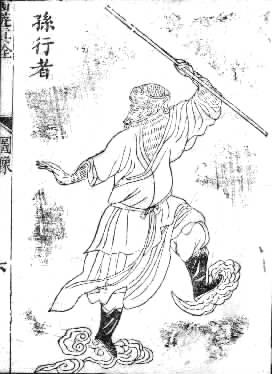
True Interpretation of Journey to the West: Image 6 – Sun Wukong
『西遊記』―玄奘と三蔵法師の物語
『西遊記』は、中国の古典文学でありながら、その物語の中心人物である玄奘三蔵法師は、実在の歴史的人物です。
彼は唐の時代にインドへの長い旅を経て、多くの仏教経典を中国へと持ち帰りました。
この壮大な冒険は、後に「大唐西域記」としてまとめられ、仏教研究の貴重な資料となっています。
玄奘の功績は、二大訳聖として称えられ、四大訳経家の一人に数えられるほどです。
彼の翻訳した経典は、中国仏教の発展に大きな影響を与えました。
また、彼の旅と学問への貢献は、後世の文学作品に大きな影響を与え、『西遊記』のようなフィクション作品にも描かれています。
『西遊記』では、玄奘は三蔵法師として、孫悟空、猪八戒、沙悟浄といった弟子たちと共に、数々の試練を乗り越えながらインドを目指します。
この物語は、彼の実際の旅に基づいているものの、神話や伝説を織り交ぜた創作が加えられており、読者に夢と冒険の世界を提供しています。
現代においても、玄奘と『西遊記』の物語は、映画、テレビドラマ、アニメーション、漫画など様々なメディアで繰り返し取り上げられています。
これらの作品は、玄奘の知識と勇気、そして彼の心の旅を象徴する物語として、多くの人々に愛され続けています。
玄奘の生涯と彼が残した遺産は、時間を超えて現代にも息づいており、彼の精神的な探求は今日の私たちにとっても尊重されるべきものです。
『西遊記』を通して、その物語は新たな世代に伝えられ、玄奘の名は永遠に記憶されることでしょう。
Journey to the West: The Tale of Xuanzang and Tripitaka
“Journey to the West” is a classic of Chinese literature, centered around the historical figure of Xuanzang Tripitaka, who lived during the Tang Dynasty.
He embarked on a lengthy journey to India, bringing back numerous Buddhist scriptures to China.
This epic adventure was later compiled into the “Great Tang Records on the Western Regions,” becoming a valuable resource for Buddhist studies.
Xuanzang’s achievements earned him the title of one of the Two Great Patriarchs of Translating Buddhist Scriptures and one of the Four Great Buddhist Translators.
His translations greatly influenced the development of Chinese Buddhism.
Furthermore, his journey and scholarly contributions left a profound impact on later literary works, depicted in fictional works such as “Journey to the West.”
In “Journey to the West,” Xuanzang appears as Tripitaka, traveling to India with disciples like Sun Wukong, Zhu Bajie, and Sha Wujing, overcoming numerous trials along the way.
While based on his actual journey, the story weaves in mythology and legend, offering readers a world of dreams and adventure.
Even today, Xuanzang and the tale of “Journey to the West” are repeatedly revisited in various media such as movies, TV dramas, animation, and manga.
These works continue to be loved by many, symbolizing Xuanzang’s knowledge, courage, and the spiritual journey he undertook.
Xuanzang’s life and his legacy resonate across time, his spiritual quest remaining a source of respect and inspiration for us today.
Through “Journey to the West,” his story is passed down to new generations, ensuring that the name of Xuanzang will be remembered for eternity.
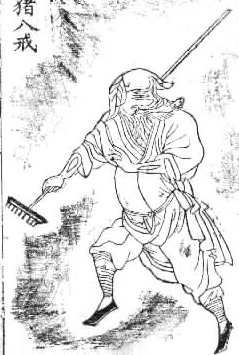
The Journey to the West: Image 7 – Zhu Bajie
玄奘を描いた他のフィクション作品
玄奘三蔵法師は、中国の伝説的な僧侶であり、彼の旅と教えは数多くのフィクション作品に影響を与えてきました。
特に『西遊記』は、彼のインドへの仏教経典の求法旅行をベースにした物語であり、猪八戒、沙悟浄、孫悟空といった魅力的なキャラクターたちと共に、玄奘の冒険が描かれています。
『西遊記』以外にも、玄奘を描いた作品は多数存在します。
彼の実際の旅を記録した『大唐西域記』は、歴史的な文献としてだけでなく、後世の創作における資源となっています。
この記録は、玄奘が経験した文化や宗教的な交流の詳細を提供し、創作家たちに豊かなインスピレーションを与えてきました。
また、玄奘は「二大訳聖」の一人として、仏教経典の翻訳において重要な役割を果たしました。
彼の翻訳作業は「四大訳経家」に数えられ、中国仏教史において非常に重要な位置を占めています。
そのため、彼の知識と献身は、学術的な研究だけでなく、文学作品においても高く評価されています。
現代のフィクション作品においても、玄奘はしばしば重要なキャラクターとして描かれます。
彼の智慧と冒険心は、新しい世代の聴衆に対しても魅力的であり、彼の物語は今なお多くの人々にインスピレーションを与えています。
これらの作品は、古典的なテーマを現代的な視点で再解釈し、新たなファンを生み出し続けています。
玄奘の人生と旅は、時代を超えて多くの人々に影響を与え、彼の遺産は今日に至るまで様々な形で受け継がれています。
彼を描いたフィクション作品は、その知的探究と精神的な旅を通じて、永遠の普遍性を持ち続けているのです。
Other Fictional Works Depicting Xuanzang
Xuanzang, the legendary monk from China, has inspired numerous fictional works with his travels and teachings.
Chief among them is “Journey to the West,” which is based on his journey to India in search of Buddhist scriptures, featuring captivating characters like Zhu Bajie, Sha Wujing, and the famous Sun Wukong, alongside Xuanzang’s own adventures.
Apart from “Journey to the West,” there are many other works that portray Xuanzang.
His actual journey was documented in the “Great Tang Records on the Western Regions,” serving not only as a historical document but also as a resource for later creative endeavors.
This record provides detailed accounts of the cultural and religious exchanges Xuanzang experienced, offering rich inspiration to storytellers.
Moreover, Xuanzang is celebrated as one of the “Two Great Patriarchs of Translation,” playing a crucial role in translating Buddhist scriptures. He is counted among the “Four Great Translators of Scriptures,” holding a significant place in Chinese Buddhist history.
Therefore, his knowledge and dedication are highly valued not only in academic research but also in literary works.
In contemporary fiction, Xuanzang often appears as a pivotal character. His wisdom and adventurous spirit continue to captivate audiences of all ages, inspiring them with his story.
These works reinterpret classical themes through a modern lens, attracting new fans and perpetuating Xuanzang’s legacy.
Xuanzang’s life and journey have influenced countless individuals across generations, and his legacy continues to be passed down in various forms to this day.
Fictional portrayals of him embody his intellectual curiosity and spiritual journey, resonating with eternal universality.
1.jpg)
Records of the Western Regions in the Great Tang Dynasty – Complete Library in Four Sections
玄奘の足跡をたどる―関連項目と学術的な研究
玄奘は、唐の時代にインドへの長い旅を経て、仏教経典を中国に持ち帰った高僧です。
彼の功績は、二大訳聖として今も讃えられ、四大訳経家の一人として仏教史にその名を刻んでいます。
『大唐西域記』は、玄奘自身が記した旅行記であり、その中には当時の中央アジアやインドの地理、文化、宗教に関する貴重な記述が含まれています。
玄奘の研究は、彼が訪れた地域の歴史や仏教の伝播に関する学術的な洞察を提供しており、多くの研究者によって引き続き探求されています。
彼の訳経活動は、中国仏教の発展に大きな影響を与え、経典の解釈と普及において重要な役割を果たしました。
玄奘の足跡をたどることは、仏教哲学だけでなく、当時の社会、経済、政治の相互関係を理解する上でも非常に有意義です。
また、玄奘が遭遇した困難や、彼が乗り越えた障害は、彼の精神的な強さと決意を物語っています。
これらのエピソードは、彼の旅に関する文献や伝記で詳細に描かれており、今日でも多くの人々にインスピレーションを与えています。
玄奘の学問的な業績と彼の伝説的な旅は、アジアの歴史と文化を研究する上で欠かせない要素となっています。
Tracing Xuanzang’s Footsteps: Related Topics and Academic Research
Xuanzang was a revered monk of the Tang Dynasty who embarked on a lengthy journey to India, bringing Buddhist scriptures back to China.
His achievements as one of the “Two Great Masters of Translation” are still celebrated today, and he is recognized as one of the “Four Great Translators of Buddhist Scriptures” in the annals of Buddhist history.
“The Great Tang Records on the Western Regions” stands as his personal travelogue, containing invaluable descriptions of the geography, cultures, and religions of Central Asia and India during his time.
Research on Xuanzang provides scholarly insights into the histories of the regions he visited and the spread of Buddhism, topics that continue to be explored by many researchers.
His translation efforts profoundly influenced the development of Chinese Buddhism, playing a crucial role in the interpretation and dissemination of scriptures.
Tracing Xuanzang’s journey is not only meaningful for understanding Buddhist philosophy but also for comprehending the societal, economic, and political interconnections of his era.
Moreover, the challenges Xuanzang encountered and overcame illustrate his spiritual strength and determination.
These episodes are vividly portrayed in the literature and biographies recounting his travels, continuing to inspire people today.
Xuanzang’s scholarly achievements and his legendary journey are indispensable elements in studying the history and culture of Asia.
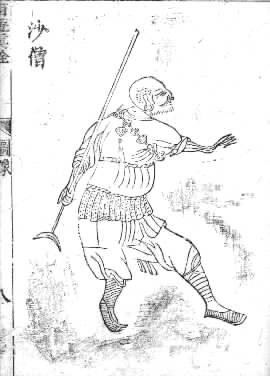
Journey to the West – Illustration 8: Sha Wujing
玄奘に関連する項目と文献
玄奘は、唐代の高僧であり、インドへの長い旅を経て仏教経典を中国に伝えた重要な人物です。
彼は「二大訳聖」の一人に数えられ、その翻訳作業は「四大訳経家」においても特筆されます。
彼の著作『大唐西域記』は、彼が目にした中央アジアやインドの地理、風俗、宗教に関する貴重な情報を提供しており、後世の研究者にとっては不可欠な文献となっています。
玄奘の旅は、彼が629年に中国を出発し、約17年後の646年に帰国するまで続きました。
その間、彼は多くの困難を乗り越え、ナランダ寺院での学問の修行を含む、多くの経験を積みました。
彼の旅路は、後の研究者たちにとって、当時の仏教伝播の様子を理解する上での重要な手がかりとなっています。
玄奘の翻訳作業は、中国仏教の発展に大きな影響を与えました。
彼が翻訳した経典は、中国の仏教徒にとって新たな視点を提供し、中国仏教の教義を形作る上で中心的な役割を果たしました。
また、彼の翻訳は、後の世代の訳経僧たちにとっても、翻訳技術の向上に寄与しました。
学術的な視点から見た玄奘の旅と影響は、仏教哲学や歴史学の分野での研究において、今なお多くの議論を呼んでいます。
彼の旅が示す文化交流や宗教的な影響は、歴史を通じてさまざまな角度から分析されてきました。
『大唐西域記』をはじめとする彼の著作は、アジア研究や宗教研究における基礎文献として、その価値を失うことはありません。
玄奘の業績は、仏教史だけでなく、中国文化やアジアの歴史においても、非常に重要な位置を占めています。
彼の旅がもたらした知識と経験は、今日においても多くの人々に影響を与え、彼の精神的な探求は、多くの人にとって尊敬と啓発の源となっています。
学術的な視点から見た玄奘の旅と影響
玄奘は、唐の時代にインドへの長い旅を経て、仏教経典の翻訳と普及に尽力した歴史的人物である。
彼の功績は、二大訳聖の一人として讃えられ、四大訳経家に数えられるほどの影響力を持っている。
彼が著した『大唐西域記』は、その旅の記録であり、後世の研究者たちにとって貴重な学術資料となっている。
玄奘が行った旅は、当時の仏教と文化の交流において重要な役割を果たした。
彼が集めた経典は、中国仏教の発展に不可欠なものであり、翻訳作業によって中央アジアやインドの思想が中国にもたらされた。
このような文化的な相互作用は、玄奘の旅が持つ学術的な意義をさらに強調する。
玄奘に関連する文献と研究は多岐にわたり、彼の生涯や業績を深く掘り下げている。
これらの研究は、彼の旅路がどのようにして仏教哲学や宗教的な実践に影響を与えたかを明らかにしている。玄奘の経験は、彼の時代を超えて、現代の学者たちにも多くの洞察を提供している。
学術的な視点から見ると、玄奘の旅は、当時の宗教的および文化的な枠組みを理解する上で不可欠な要素である。
彼の記録は、7世紀のアジアの地理や社会に関する貴重な情報源となっており、その詳細な記述は研究者たちにとって大変な価値がある。
総じて、玄奘の旅とその影響は、仏教研究はもちろんのこと、歴史、地理、文化交流の研究においても重要なテーマであり続ける。
彼の生涯と業績を通して、我々は古代の世界における人々の思想や生活をより深く理解することができるのである。
Exploring Xuanzang’s Footsteps – Related Topics and Literature
Xuanzang was a prominent monk of the Tang Dynasty who undertook a lengthy journey to India, bringing Buddhist scriptures back to China.
He is celebrated as one of the “Two Great Masters of Translation” and is honored as one of the “Four Great Translators of Buddhist Scriptures” in the history of Buddhism.
His work “The Great Tang Records on the Western Regions” is his personal travelogue, containing valuable insights into the geography, customs, and religions of Central Asia and India during his time.
Studies on Xuanzang provide scholarly insights into the history of the regions he visited and the dissemination of Buddhism, continuing to be explored by many researchers.
His translation efforts profoundly influenced the development of Chinese Buddhism, playing a crucial role in the interpretation and spread of scriptures.
Tracing Xuanzang’s journey is meaningful not only for understanding Buddhist philosophy but also for comprehending the societal, economic, and political dynamics of his era.
Moreover, the challenges he faced and overcame during his journey exemplify his spiritual strength and determination.
These episodes are vividly detailed in the literature and biographies of his travels, continuing to inspire people today.
Xuanzang’s scholarly achievements and his legendary journey remain indispensable elements in studying the history and culture of Asia.
玄奘研究のためのリソース―外部リンクと参考文献
玄奘は、中国唐代の高僧であり、仏教経典の翻訳において重要な役割を果たした人物です。
彼は「二大訳聖」の一人として知られ、『大唐西域記』の著者としても名高いです。
彼の旅と研究は、後の「四大訳経家」にも大きな影響を与えました。玄奘の業績を深く理解するためには、豊富なリソースと正確な参考文献が不可欠です。
外部リンク集には、玄奘に関する学術論文、彼の旅路を辿るドキュメンタリー、また彼が訳出した経典のデジタル版などが含まれています。
これらの資料を通じて、研究者や興味を持つ一般の人々は、玄奘の足跡をたどり、彼の思想と仏教に対する貢献を深く掘り下げることができるでしょう。
玄奘研究における重要な脚注と出典は、彼の翻訳作業の精度とその時代の文化的背景を理解する上で欠かせません。
研究者たちは、彼が訳した経典の原文と比較分析を行うことで、当時の翻訳技術や言語学的な側面に光を当てています。
また、玄奘が訪れた地域の歴史や文化に関する研究も、彼の記述を解釈する上で重要な情報源となっています。
玄奘の研究は、仏教史だけでなく、中世のアジアにおける文化交流の研究にも寄与しています。
彼の旅がもたらした影響は、現代においても多くの学者によって評価され続けています。
興味深いのは、玄奘の経典翻訳が、後世の仏教伝播にどのように影響を与えたかという点です。
このリソースの提供を通じて、玄奘の研究がさらに発展し、彼の功績が幅広い視点から評価されることを願っています。
玄奘の生涯と仏教への貢献は、今後も多くの人々にとって大きな魅力となるでしょう。
さらなる探求のために―外部リンク集
外部リンク集を探索することは、玄奘の生涯や業績に関する理解を深める上で欠かせないステップです。
特に、彼が果たした「二大訳聖」の一人としての役割や、「四大訳経家」の一角としての貢献は、仏教文化と中国歴史において重要な位置を占めています。
彼の旅路と学問的遺産を記した『大唐西域記』は、当時の社会や宗教的背景を理解するための貴重な資料として現在も多くの研究者に参照されています。
玄奘研究においては、彼の翻訳した経典や、その翻訳に関わる詳細な脚注、出典を含む多くの参考文献が存在します。
これらの文献は、玄奘の思想と彼が遭遇した時代の文化的複雑さを解き明かす手がかりを提供し、彼の旅と翻訳に関する深い洞察を可能にします。
外部リンク集には、玄奘に関連するアーカイブ、デジタルライブラリ、学術論文のデータベースへのリンクが含まれており、研究者や学生はこれらのリソースを利用して、彼の研究における新たな視点を発見することができるでしょう。
それぞれのリンクは、玄奘の足跡をたどり、彼の翻訳作業や教義に対する理解を深めるための窓口となります。
研究における重要な脚注と出典は、玄奘の著作や彼に関する記録を正確に解釈するための基礎を築きます。
これらの情報は、詳細な文献レビューや歴史的文脈の考察を通じて、玄奘の研究がどのように進展してきたかを示すものです。
玄奘の研究は、彼の旅と翻訳作業が仏教の伝播に与えた影響を理解するための重要な一環です。
外部リンク集を通じて得られる資料は、この偉大な訳聖の遺産をさらに探求するための道しるべとなるでしょう。
玄奘研究における重要な脚注と出典
玄奘の研究は、その旅と翻訳がもたらした仏教哲学への影響を理解する上で不可欠です。
彼は「二大訳聖」の一人として讃えられ、「四大訳経家」の中でも特に重要な位置を占めています。
玄奘の旅行記である『大唐西域記』は、中央アジアやインドの仏教に関する貴重な情報を提供し、後世の研究者にとって重要な資料となっています。
玄奘に関する研究においては、彼の翻訳した経典や著作の校訂版をはじめ、彼の生涯や旅路を辿る多くの研究書が出典として挙げられます。
これらの文献は、彼の思想や翻訳技術、その時代の文化的背景を解明するために不可欠なものです。
研究における脚注と出典の正確性は、学術的な議論を構築する上で基盤となります。
玄奘の業績を深く掘り下げる際には、原典の確認や異なる研究者の解釈を比較検討することが求められます。
そのためには、信頼性の高い図書館やオンラインデータベースへのアクセスが必要不可欠です。
さらに、玄奘に関する最新の研究成果や論文を参照することで、既存の知見を更新し、新たな視点を提供することが可能になります。
これは、玄奘の教えが現代にもたらす意義を再評価する上で、重要なプロセスとなります。
最後に、玄奘研究における重要な脚注と出典を探求する際には、彼の伝記や旅行記の翻訳版だけでなく、彼が訳した経典の注釈や解説も参照することが推奨されます。
これにより、彼の翻訳作品が当時の中国仏教に与えた影響の全容を把握することができるでしょう。
Resources for Xuanzang Studies – External Links and References
Xuanzang, a prominent monk of the Tang Dynasty in China, played a crucial role in translating Buddhist scriptures.
He is renowned as one of the “Two Great Masters of Translation” and is particularly famous as the author of “The Great Tang Records on the Western Regions.”
His journeys and studies greatly influenced later “Four Great Translators of Buddhist Scriptures.” To deeply understand Xuanzang’s achievements, abundant resources and accurate references are essential.
External links include scholarly articles on Xuanzang, documentaries retracing his journey, and digital versions of the scriptures he translated.
Through these materials, researchers and interested individuals can delve into Xuanzang’s footsteps and explore his contributions to Buddhist thought.
Critical footnotes and sources in Xuanzang studies are indispensable for understanding the precision of his translation work and the cultural context of his time.
Scholars illuminate linguistic aspects and translation techniques of his era by comparing the original texts of scriptures he translated.
Studies on the history and culture of the regions Xuanzang visited also provide crucial insights for interpreting his writings.
Xuanzang’s studies contribute not only to Buddhist history but also to research on cultural exchanges in medieval Asia.
The impact of his travels continues to be esteemed by scholars today.
Of particular interest is how Xuanzang’s translations influenced subsequent spread of Buddhism.
Through these resources, we hope Xuanzang’s studies will further develop and his contributions will be evaluated from diverse perspectives.
Xuanzang’s life and contributions to Buddhism will continue to captivate many in the future.
For Further Exploration – External Links Collection
Exploring external links is an essential step in deepening understanding of Xuanzang’s life and achievements.
His role as one of the “Two Great Masters of Translation” and his contributions as part of the “Four Great Translators of Buddhist Scriptures” hold significant positions in Buddhist culture and Chinese history.
His travelogue and academic legacy, “The Great Tang Records on the Western Regions,” continue to be referenced by numerous researchers as invaluable sources on the society and religious background of the time.
In Xuanzang studies, a wealth of references exist, including annotated versions of scriptures he translated and detailed footnotes on his works and life journey.
These documents provide clues to unraveling Xuanzang’s thoughts and insights into the cultural complexities of his era and his journey and translations.
External links encompass archives related to Xuanzang, digital libraries, and databases of scholarly articles, allowing researchers and students to discover new perspectives in his studies.
Each link serves as a gateway to trace Xuanzang’s footsteps and gain deeper insights into his translation work and doctrinal contributions.
Accurate footnotes and references in research build the foundation for interpreting Xuanzang’s writings and records.
These sources reveal how Xuanzang’s translations and his encounters influenced Buddhist philosophy and religious practices at the time.
Exploring these resources is crucial for advancing the understanding of this great translator’s legacy.
In conclusion, exploring critical footnotes and references in Xuanzang studies involves consulting not only translations of his biographies and travelogues but also annotations and explanations of scriptures he translated.
This approach allows for a comprehensive understanding of how his translation works shaped Chinese Buddhism of his time.

Warning: Undefined variable $comment_form_sns_tags in /home/ktsky/philosophy-kayak.com/public_html/wp-content/themes/shaper/comments.php on line 27